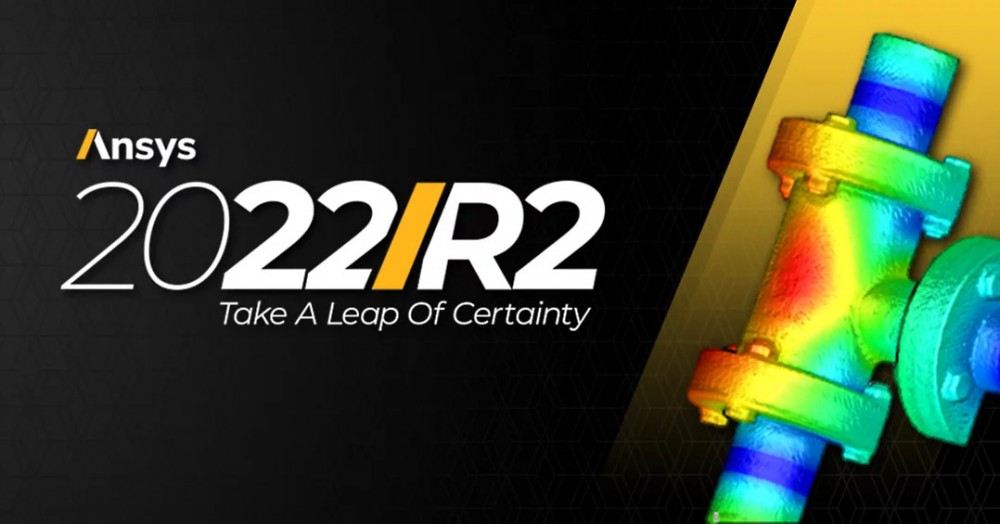Member Login
Ansys 2022 R2 Ignites Engineering Innovation with Greater Product Design and Development Insights
2022.08.30Innovative new simulation solutions and technologies equip visionary design teams with the insights needed to see what others cannot.
Key Highlights
- New AI capabilities and simulation technologies deliver insight-driven innovation across every dimension of product design and development
- Open workflows enhance collaboration and increase productivity across engineering disciplines
- GPU solver advances show up to 4x power savings because four GPUs display performance similar to 1,000 CPU cores
Ansys enables engineering teams to see through complexity and design the next generation of world-changing products. The new capabilities in Ansys 2022 R2 cross the breadth of physics, engineering disciplines, and industries to support the scale and interoperability needed to gain knowledge of real-world product performance.
It's nearly impossible to solve today’s complex product design challenges without insight into everything from microscopic defects in semiconductor chips to global operating environments that reach into space. Understanding the interaction of heat, light, sound, structural stress, electromagnetic waves, and embedded software systems is critical to successful product development. Ansys 2022 R2 provides the predictively accurate analysis, artificial intelligence/machine learning (AI/ML) optimization, and scalable platform needed to tackle tough engineering challenges while meeting tight deadlines.
“Our project was very technology-driven, and despite the challenges inherent in producing a unique relay design, our engineering team was able to develop the ideal component within an extremely tight time frame,” said Christian Muller, senior specialist of development for electromechanics at Phoenix Contact. “Without simulation and digital twins, the entire design project would simply not have been possible. However, that is just the beginning. Durability tests are very complex and expensive to perform, so simulating those will enable us to speed up the process even more. Ansys simulations will enable us to get to the exact values that will reduce the engineering time.”
Insight-Driven Innovation
Ansys 2022 R2 provides insights that multiple industries can use to meet their goals. For example, Ansys® Granta™ products help engineers factor in material sustainability earlier in the design process. By displaying the latest sustainability data in simulation and computer-aided design (CAD) tools, engineers from multiple industries can gain perspective on material choices as part of their eco-design strategies.
Another example of industry-spanning benefits can be found in optics where new features in Ansys® Speos™ optical simulation software save time by automatically creating the back face of a lens. This helps automotive lighting designers create lenses that achieve specific beam patterns, which also helps the general lighting industry create custom light patterns and control light pollution.
Model-based simulation and digital twins are helping leading organizations transform to embrace streamlined, insight-driven business models. For instance, Ansys® Maxwell® 2022 R2 electromechanical device analysis software provides reduced-order models (ROMs) for induction machines with improved predictive accuracy, which can be used in Ansys® Twin Builder™ for electric vehicle drive system simulations.
“With the increased popularity and complexity of electric vehicles, model-based simulation is critical for evaluating and validating multiple designs,” said Takashi Miyamori, director, Toshiba Electronic Devices & Storage Corporation (Toshiba). “Toshiba, in collaboration with Ansys and its Ansys Twin Builder system simulation technology, has developed a new toolkit for design and validation of automotive electrical systems. The Accu-ROM™ (Accurate Reduced-Order Modeling) Toolkit for System Simulation enables high-precision and high-speed system simulation for both electronic circuits and mechanical components, shortening verification times for automotive semiconductors by about 90%.”

Ansys Twin Builder updates in 2022 R2 include the new Toshiba Accu-ROM™ Toolkit for simulation of the electric power steering system, which enables fast simulation for both the electronic circuits and mechanical components.
Scalable, Open Workflows
Ansys 2022 R2 delivers technical innovations that connect physics and disciplines across scales. For example, Ansys® LS-DYNA® is used by leaders in automotive crash, electronics drop tests, airbag deployment, and impact analysis. The new release includes a patent-pending, multi-scale co-simulation capability engineers use to predict solder ball fatigue failure in a printed circuit board (PCB) within a broader macro-scale drop test.
Imagine that same PCB is destined to be used in one satellite in a “mega constellation" that includes hundreds to tens of thousands of satellites. With Ansys STK 2022 R2, engineers can include the satellite collection object within chained calculations to better analyze and understand complex routing options for connecting ground-based assets.
Ansys 2022 R2 allows organizations to build custom workflows for industry-specific applications while extending broad, ease-of-use features that turbocharge an organization. A few examples are listed below.
- A magnetic latching coupling workflow leverages Maxwell and Ansys® Motion™ to improve magnetically attached accessories for tablets and e-readers.
- A noise, vibration, and harshness workflow combines solutions across physics to provide simulation of electric machines with complete electromagnetic, thermal, mechanical stress, sound, and drive cycle analyses.
- Ansys Lumerical helps photonic integrated circuit designers move freely between the Lumerical INTERCONNECT environment and popular design automation tools for integrated circuit layout and manufacturing, while including semiconductor process variations.
- The Ansys® HFSS™ Flex PCB workflow helps engineers set up and solve complex bends within flexible PCB interconnects, improving efficiency and predictive accuracy by including full fidelity electromagnetic coupling effects.
- The capabilities of encrypted HFSS components have been extended to support integrated circuit design flows, enabling engineers who work with foundry technology files to protect sensitive intellectual property.
- Users can now automate processes, build custom workflows, craft customized solutions, and more with PyFluent, the open-source access to Ansys® Fluent®, via the Python programming language.
- A customizable toolbar for Ansys® Mechanical™ add-ons empowers users to access multipurpose workflows quickly and efficiently.
- Electronics reliability PCB component lifetime predictions have been enhanced for customers in the aerospace, high-tech, and automotive industries.
Platform-Powered Performance
As simulations become larger and more complex, Ansys 2022 R2 empowers users to run large jobs and overcome hardware capacity limitations with HPC and enhanced solver algorithms that take advantage of graphic processor units (GPUs).
In Ansys 2022 R2, the Fluids product line continues to make computational fluids dynamics (CFD) simulations more efficient and sustainable. Results using the Live-GX solver in Fluent show that six high-end GPUs provide the same performance as more than 2,000 CPUs.
The Speos optical solver takes advantage of multi-GPU, multi-node deployments. A single GPU is up to 8x faster than a 32-core CPU machine, and 20 GPUs show similar performance to 5,000 CPU cores. The new capability in Speos enables users to increase the number of rays to boost simulation predictive accuracy, consider weather conditions at night for sensor validation, and simulate any stray light effect.
Ansys 2022 R2 includes two new semiconductor products – Ansys® Totem-SC™ and Ansys® PathFinder-SC™ – for power integrity and electrostatic discharge reliability signoff, respectively. These products use Ansys® SeaScape™, a cloud-optimized, elastic compute platform, to deliver remarkable speed and capacity for the largest designs. Ansys internal testing showed that large simulation runs can complete up to 6x faster with reduced memory.
“Ansys 2022 R2 gives organizations the ability to bring together different perspectives across engineering disciplines to see what competitors miss, to redefine product performance, and open up new areas of innovation within every industry,” said Shane Emswiler, senior vice president of products at Ansys. “Ansys 2022 R2 delivers an unprecedented range of new capabilities, performance improvements, and cross-discipline engineering solutions that allow teams to fully understand every dimension of their next generation products.”
To learn more about Ansys 2022 R2, please visit: https://www.ansys.com/products/release-highlights.
About Ansys
When visionary companies need to know how their world-changing ideas will perform, they close the gap between design and reality with Ansys simulation. For more than 50 years, Ansys software has enabled innovators across industries to push boundaries by using the predictive power of simulation. From sustainable transportation to advanced semiconductors, from satellite systems to life-saving medical devices, the next great leaps in human advancement will be powered by Ansys.
Take a leap of certainty … with Ansys.
Ansys and any and all ANSYS, Inc. brand, product, service and feature names, logos and slogans are registered trademarks or trademarks of ANSYS, Inc. or its subsidiaries in the United States or other countries. All other brand, product, service and feature names or trademarks are the property of their respective owners.
About CYBERNET
As a leading CAE technology and service provider, CYBERNET SYSTEMS CO.,LTD., headquartered in Tokyo, Japan, has been helping its customers since 1985 by offering software, training, technical support, and consulting services to a broad spectrum of organizations, including the R&D and design-related sectors of the manufacturing industry and academic and government research institutes.
CYBERNET SYSTEMS MALAYSIA SDN.BHD., a wholly-owned subsidiary of the group company, supports its customers in Malaysia, Singapore, Thailand, Vietnam, and other countries of the ASEAN region. They provide a wide variety of services ranging from Computer-Aided Engineering (CAE) solutions including Photonics, Optics and VR design, Vehicle Simulation products, Casting Simulation systems, to solutions that combine CAE with emerging technology for Digital Transformation such as the IoT, digital twins, big data analysis, and AI.
CYBERNET SYSTEMS MALAYSIA SDN. BHD. is an Ansys Channel Partner.
Contact us: [email protected]


